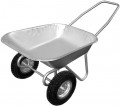Wheel diameter
The diameter of the wheel(s) of a wheelbarrow or trolley (see "Type"). Permeability primarily depends on this parameter: the larger the wheel, the less sensitive it is to pits and irregularities, and the easier it is to carry the entire structure over rough terrain. At the same time, in carts (including ladders, see "Type"), the diameter of the wheels is relatively small — it rarely exceeds 250 mm. But for wheelbarrows 200 – 250 mm is considered a very limited indicator — most models use wheels with a diameter of 300 to 400 mm.
Load capacity
Wheelbarrow / trolley capacity — the maximum weight of the load that can be constantly carried on it.
In this case, a load capacity
of up to 150 kg is considered small; wheelbarrows in this category are intended mainly for gardening, and carts for relatively small loads like a sack of potatoes or a couple of sacks of cement. Models for
150 – 200 kg can be attributed to the middle category, among them it already makes sense to look for cars for construction work of a relatively small volume. And in the most durable and "hardy" products, this figure can
exceed 200 kg, reaching 500 kg or even more.
It is worth noting that most modern wheelbarrows / carts (especially at the beginning of operation) can easily carry short-term loads that exceed the claimed carrying capacity without visible consequences. However, overloading the structure is highly discouraged: in such cases, it will experience off-design stress, which reduces the overall service life and increases the risk of failure at the most inopportune moment.
Wheel guard
The presence of a
strut in the design of the wheelbarrow (see "Type").
A strut is called a fixture in the area of \u200b\u200bthe front wheel (s); it can be made as a U-shaped piece between the wheels, a pipe around the wheel, two separate shaped pipes in front of each wheel, and the like. Anyway, the strut significantly simplifies the unloading of the wheelbarrow: with a strong forward tilt (for example, if you need to pour sand on a pile), it rests on the ground and works as a support — this is much more convenient and safer than resting the wheelbarrow on a freely spinning wheel.
In addition, the strut can play the role of a third support (along with the support legs) even if the wheel needs to be removed — for example, to close a hole.
Handle type
The design of the handle provided in the wheelbarrow / trolley.
The main types of handles nowadays are
H-shaped and
U-shaped. There are also combined H / U-shaped structures, as well as rarer and more specific varieties — T-shaped and D-shaped. Here are the features of all these options.
— H-shaped. Handles of this type have two characteristic handles, which are supposed to be held with two hands during use. This option is most popular in wheelbarrows (see "Type"): the handles are usually located at a fairly significant distance, so that a person can fit between them and keep his hands not in front of him, but at his sides. This position is considered the most suitable for transporting heavy loads on wheelbarrows, especially one-wheeled ones. But trolleys with such handles are much less common: the load in them is distributed differently, moreover, the H-shape makes it difficult to hold with one hand, which is often required in the case of trolleys.
— U-shaped. Handles in the shape of the letter P — two pipes connected by a transverse jumper; It is for this jumper that it is supposed to hold on. This form, on the contrary, is extremely rare in wheelbarrows, but very popular in carts: it is less suitable for lifting a lot of weight up (as you have to do when working with a wheelbarrow), but it is perfectly controlled even with one hand (which is very important for carts).
...— N / U-shaped. Handles that combine both of the structures described above — both the H-shaped paired handles and the U-shaped crossbar. This makes it possible to choose the option that is best suited to a particular situation. However, when held by paired handles, such handles (with rare exceptions) do not allow the hands to be held to the sides of the body, as in the traditional H-shape. Therefore, most models with this feature are trolleys (see "Type") — for them, two-handed holding in the "hands on the sides" format is not required.
— T-shaped. The handle is in the form of the letter T — a transverse crossbar installed perpendicular to the main bar. Most often, this crossbar is straight, but in some models, the ends of the crossbar can be bent back, forming the letter Y. However, this is a rather specific type of handle that is rare — in certain models of carts (see "Type").
— D-shaped. An even rarer, even exotic option is a loop-shaped handle similar in shape to the letter D. Usually, such handles are designed exclusively for one hand, and therefore are found only in single models of trolleys.Weight
Total weight of an empty wheelbarrow/cart in standard working configuration (if equipped with detachable support legs — with legs installed, see above). This parameter allows you to estimate how much excess weight you will have to carry with you in addition to the actual cargo. However it doesn't always make sense to chase light weight — it can mean less strength.

